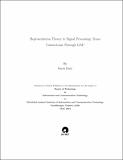Please use this identifier to cite or link to this item:
http://drsr.daiict.ac.in//handle/123456789/101| Title: | Representation theory in signal processing: some connections through gap |
| Authors: | Sinha, Virendra P. Dixit, Parth |
| Keywords: | Groups Representation of groups Representation theory Signal processing |
| Issue Date: | 2005 |
| Publisher: | Dhirubhai Ambani Institute of Information and Communication Technology |
| Citation: | Dixit, Parth (2005). Representation theory in signal processing : some connections through gap. Dhirubhai Ambani Institute of Information and Communication Technology, vi, 79 p. (Acc.No: T00064) |
| Abstract: | This thesis is concerned with the study of some of the recent developments in the area of signal processing that arise from the connections of discrete transforms and their inherent symmetries with the representation theory of groups. There are two main aspects of these developments, one, that of unification and generalization and, two, that of constructing fast algorithms for the implementation of matrix transforms. The focus of this thesis is on the second line of developments - that of constructing fast algorithms. The central theme of recent work in this direction is that of defining symmetries of a transform in terms of a pair of group representations, and then decomposing the representations along a chain of subgroups. Such a decomposition leads to a factorization of transform matrices into product of sparse matrices, which provide a means of fast transform computations. The decomposition process relies on results of group representation theory not commonly familiar to workers in the area of digital signal processing. Furthermore, the algebraic computations involved would be enormously difficult without the use of computer algebra tools and software packages of recent origin whose potential is only now beginning to be realized. On both counts, there is a need for providing a bridge between what is commonly understood of fast transforms and what the recent developments mean for them. With this need in mind, an attempt has been made in this thesis to (a) identify and discuss the relevant representation theory results, and (b) present results of hands-on experience, in the form of examples, with the software package called GAP (acronym for Groups, Algorithms and Programmes) in transform factorization. |
| URI: | http://drsr.daiict.ac.in/handle/123456789/101 |
| Appears in Collections: | M Tech Dissertations |
Files in This Item:
| File | Description | Size | Format | |
|---|---|---|---|---|
| 200211032.pdf Restricted Access | 303.77 kB | Adobe PDF |  View/Open Request a copy |
Items in DSpace are protected by copyright, with all rights reserved, unless otherwise indicated.
